Alan Cathcart | December 15, 2018
Steering the BMW Ship
BMW’s got a new CEO, and he’s got plans to make the company the number one in motorcycle and scooter sales worldwide. Alan Cathcart sat down with him at EICMA to hear what he has in store.
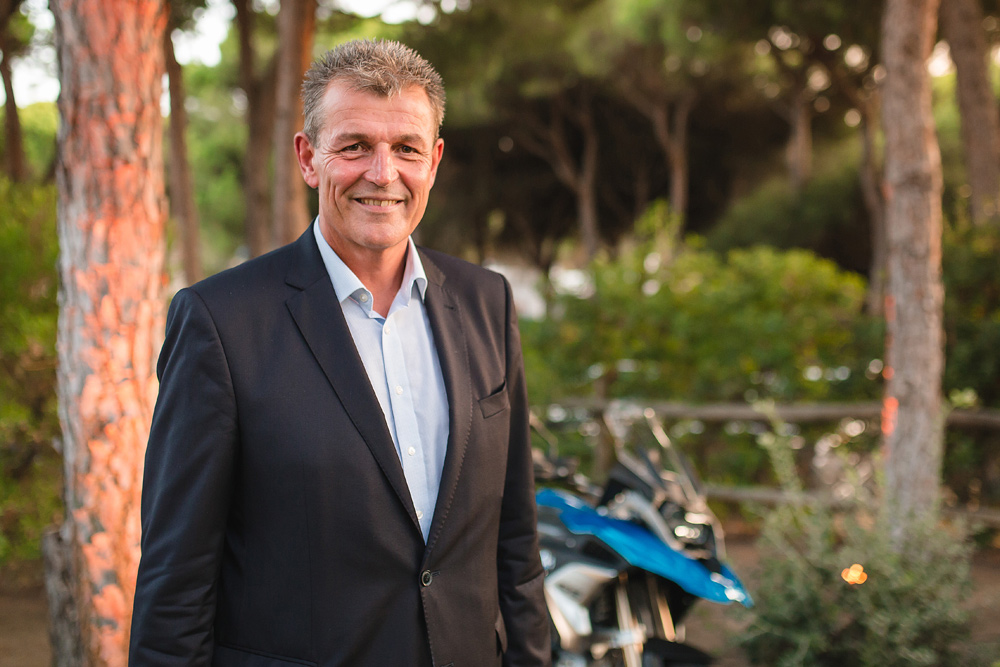 Markus Schramm has been with BMW for nearly 30 years, but this is the first time he’s solely headed up the two-wheeled arm of the company. He has some big plans for BMW.
Markus Schramm has been with BMW for nearly 30 years, but this is the first time he’s solely headed up the two-wheeled arm of the company. He has some big plans for BMW.
As it heads towards its centenary as a motorcycle manufacturer in 2023, BMW Motorrad continues to be the largest European producer of premium motorcycles and scooters.
In 2017, it delivered 164,153 such products to customers worldwide, clocking up its seventh annual sales record in succession via its 1200-plus dealers in 90 countries, as overall sales increased by 13.2 percent from 2016—a figure it’s hoping to beat this year.
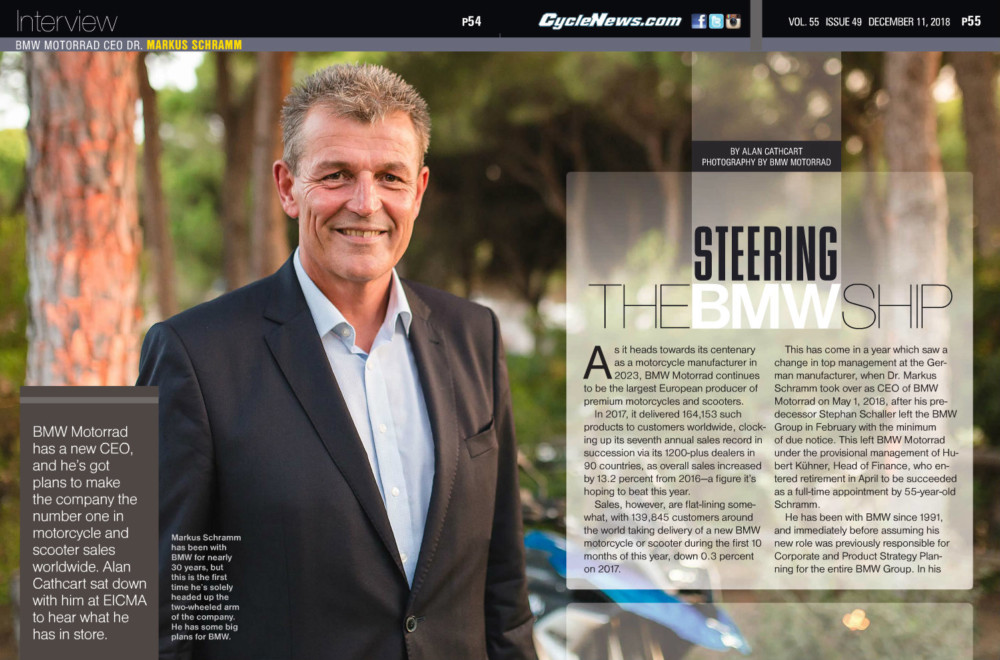
Photography by BMW Motorrad
Sales, however, are flat lining somewhat, with 139,845 customers around the world taking delivery of a new BMW motorcycle or scooter during the first 10 months of this year, down 0.3 percent on 2017.
This has come in a year which saw a change in top management at the German manufacturer, when Dr. Markus Schramm took over as CEO of BMW Motorrad on May 1, 2018, after his predecessor Stephan Schaller left the BMW Group in February with the minimum of due notice. This left BMW Motorrad under the provisional management of Hubert Kühner, Head of Finance, who entered retirement in April to be succeeded as a full-time appointment by 55-year-old Schramm.
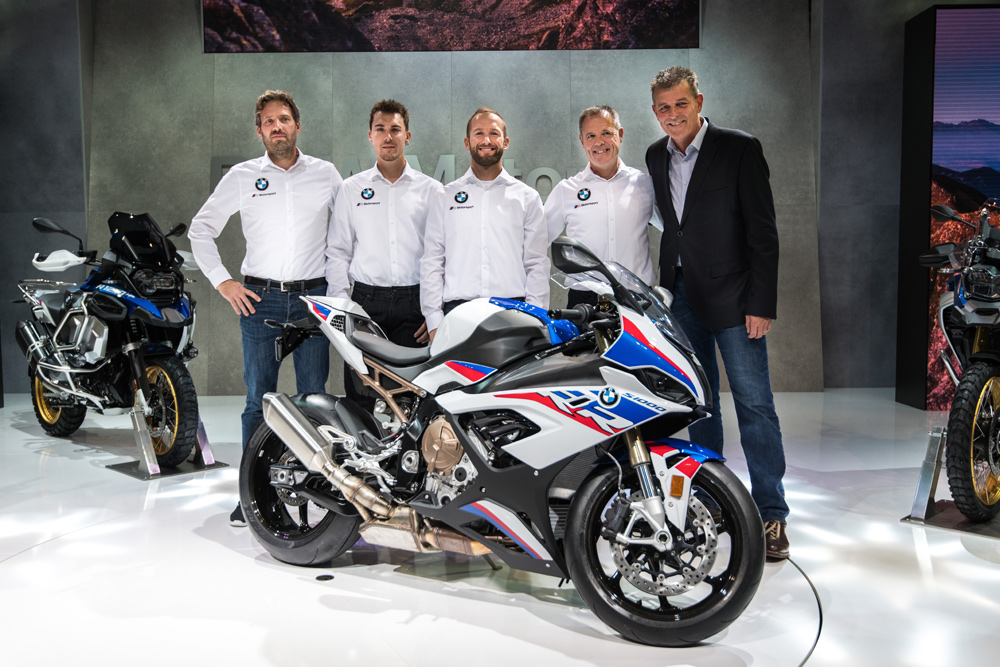 BMW will be back in WorldSBK with an officially backed team, headed by lead rider and former WorldSBK Champion Tom Sykes (center) and German SBK Champion, rider Markus Reiterberger (right of Sykes).
BMW will be back in WorldSBK with an officially backed team, headed by lead rider and former WorldSBK Champion Tom Sykes (center) and German SBK Champion, rider Markus Reiterberger (right of Sykes).
He has been with BMW since 1991, and immediately before assuming his new role was previously responsible for Corporate and Product Strategy Planning for the entire BMW Group. In his spare time, Schramm is an ardent longtime motorcyclist and accomplished marathon runner, one of the 133 members of the elite Marathon Grand Slam Club comprising runners who have completed a marathon on each of the seven continents as well as on the frozen Arctic Ocean, by running in the grueling North Pole Marathon!
By widespread assent, BMW “won” EICMA 2018, in presenting six world premiere new models at the Milan Show in November, headlined by the all-new S 1000 RR. The chance to speak at length there with Markus Schramm one on one, uncovered some key pointers for BMW Motorrad’s future direction.
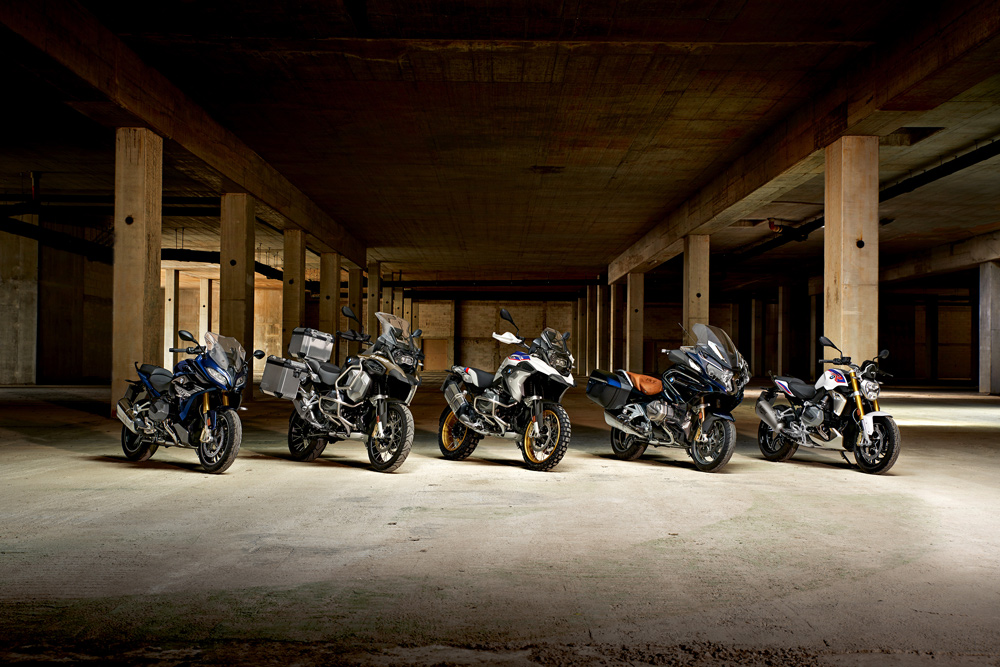 EICMA saw six new models, four of which are here left to right in the R 1250 RS, R 1250 GS Adventure, R 850 GS Adventure, R 1250 RT, and the already released G 310 R.
EICMA saw six new models, four of which are here left to right in the R 1250 RS, R 1250 GS Adventure, R 850 GS Adventure, R 1250 RT, and the already released G 310 R.
Markus, BMW Motorrad is on track to at least maintain its current sales volume in 2018, albeit without any significant growth. In your previous job, you were Head of Corporate Strategy for the BMW Group, and as such presumably responsible for initiating the path that BMW Motorrad has followed recently. Are you satisfied that things have worked out in the way that you intended them?
Yes, I think so. Being responsible for the BMW Group planning meant I was also involved in determining the motorcycle division’s product strategy, and I believe we have an extremely broad range in our model portfolio, and at the same time, a very good ongoing development of the brand in the premium motorcycle and maxi-scooter sectors.
Maintaining this status is my number-one priority—our greatest asset is the BMW brand. We are on target for an eighth successive year of growth, but we’ve had a difficult year in achieving this because the timing of development brought us several new models at the end of the year. We are leaders in some segments and some markets, but it’s my goal to become a leader in all segments, and all markets.
Do you feel your entry into the scooter market has been satisfactory and according to plan?
I think the scooter market is very important for us. On the one hand, we showed several times before we can enter a new segment, and be very successful in that. We did it with the Double-R Superbike, we did it with our small-capacity G 310 made in India, but also with the scooters. And the scooter market is not only important for attracting young people to BMW, but also for electro-mobility. You will see this coming very soon in urban areas, and you cannot offer electro-mobility scooters without having any position in the overall scooter market. I believe our new C 400 X is very attractive, and it seems the excellent response we’ve had to it from the media and also from fans of the BMW brand confirms that. It works! And now we have launched the C 400 GT at EICMA.
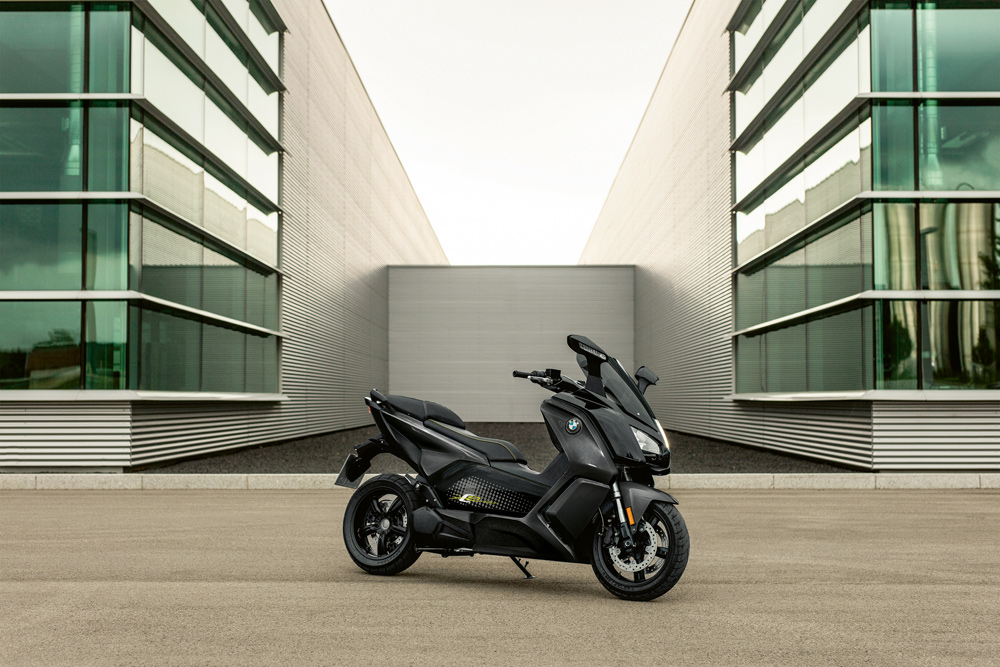 The C evolution scooter has paved the way for BMW’s e-mobility technology to eventually make it onto full-sized motorcycles.
The C evolution scooter has paved the way for BMW’s e-mobility technology to eventually make it onto full-sized motorcycles.
With the new C 400 GT, you’ve created a product that is very BMW, and unlike anything else in that quite significant midsize scooter market segment. Do you plan to go even lower in capacity—to 250cc, say, which is a much larger though maybe even more price-conscious segment?
We are now concentrating on delivering market success with the 400cc models, and having the brand develop around them. That’s the number-one priority. I’m not prepared to allow any compromise on quality to achieve a specific price target, so we’ll be focusing on this 400cc segment, we’ll see electro-mobility scooters developing, but that’s all for now.
Your C evolution electric scooter has been in production since 2014, but only in relatively small numbers. BMW is the market leader in electric four-wheelers in Europe, with the i3 and i8. So, do you plan to go into electric motorcycles as well as scooters?
I think in terms of electro-mobility, on the development side we will see urban mobility products dominating, so we are going into E-scooters even more, and you will soon see more such products from BMW. We are indeed also thinking about other EV products besides scooters, but not just yet. We want to do it step-by-step, and the primary focus for us right now is on E-scooters. So, for example I can’t imagine having an electric Enduro model yet, but we’ll see!
A very important thing is electro-mobility in two-wheelers is different from the car industry. In the car sector, it’s basically government regulations which force the industry, and thereby the customer, into E-mobility. But then the customers say, “Oh, that’s actually quite fun to drive.” With ongoing development of battery technology, it really makes it fun to drive these vehicles. But in the motorcycle industry you are not forced to ride electric, and therefore your decision to do so is decided by how much fun it is to ride such a vehicle. That means it’s customer driven, and so I think it’s important to direct our strategy with this in mind.
The Fantic Caballero electric street enduro was launched at EICMA, as a trail bike with the convenience and cleanliness of electric propulsion. Is this something BMW should be thinking about?
We are working on this! I’m convinced that the next generation of battery technology, which is due around 2021, will result in many more real-world EV products for customers, and we are therefore in a good position at BMW. Other companies with a lower technology level can try to match us, but we are the pioneers of this evolution in electro-mobility, so we do not need to jump on each and every train that comes passing. Instead, we will clearly focus on developing real-world products for the customer.
The development of lithium-ion battery technology in terms of range and recharging, as well as cost, is what is most important in making electro-mobility both practical and affordable. I think the range issue for the motorcycle industry is not as important as for cars, because while it depends on the kind of bike you are riding, you already have ranges of 136-142 miles, and this is quite sufficient for most users.
 The new Shift Cam Technology that first debuted on the R 1250 GS and S 1000 RR will make its way to the S 1000 R in the near future.
The new Shift Cam Technology that first debuted on the R 1250 GS and S 1000 RR will make its way to the S 1000 R in the near future.
At the other end of the price and volume scale from electric, are you satisfied with the market penetration that you’ve had with the BMW G 310 R and G 310 GS models built in India by TVS?
In general we are very satisfied, because we have demand out-stripping supply, so we are in discussion with TVS to increase production. Up to the end of October this year we have sold 18,000 units, with a split of 55 percent to 45 percent in favor of the older R-version, so they are very close together.
Will you develop other models based on the G310 single-cylinder platform?
For the moment we’ll leave it just with those two existing models.
Now Royal Enfield, the biggest middleweight manufacturer in India, has produced a twin-cylinder 650, are you thinking of doing the same? Will BMW produce, say, a 600cc Boxer model made in India?
At the moment, I think we are very well positioned with our middleweight class models. We have great success, the bar is high, the customers are happy, and we still have potential to enlarge the family.
But, as always, strategic thinking is continually looking at spots in the market that are attractive to attack. So, of course, we have looked at the possibilities to extend our range in that way, but we don’t have a serious plan or decision to do so yet. We will continue to focus on the existing two single-cylinder models for now.
Moving back to the other end of the scale again, what plans are there to extend BMW’s RTM/Resin Transfer Moulding leadership in low-cost carbon-fiber production? May I presume that the new S 1000 RR would be a good platform for this?
Yes, it’s a good example. I think we have very good synergies with other divisions in the BMW Group, allowing us to take advantage of our competence in carbon-fiber production. The extension of the M-brand to motorcycles will give even more support on this.
The most significant market segment that BMW is not present in now is the Cruiser sector. BMW was very successful with the R 1200 C made between 1997 and 2004, manufacturing over 40,000 examples—but nothing since. Are there any plans for BMW to return to the Cruiser market?
(laughs). The American market is big, and our market share is small. Why is our market share small? It’s because the single biggest dominant segment is the cruiser segment, and I can tell you we are no longer just sitting and looking at how big the cruiser segment is! We will come with a very emotional and attractive and authentic BMW solution to this segment not so very far in the future.
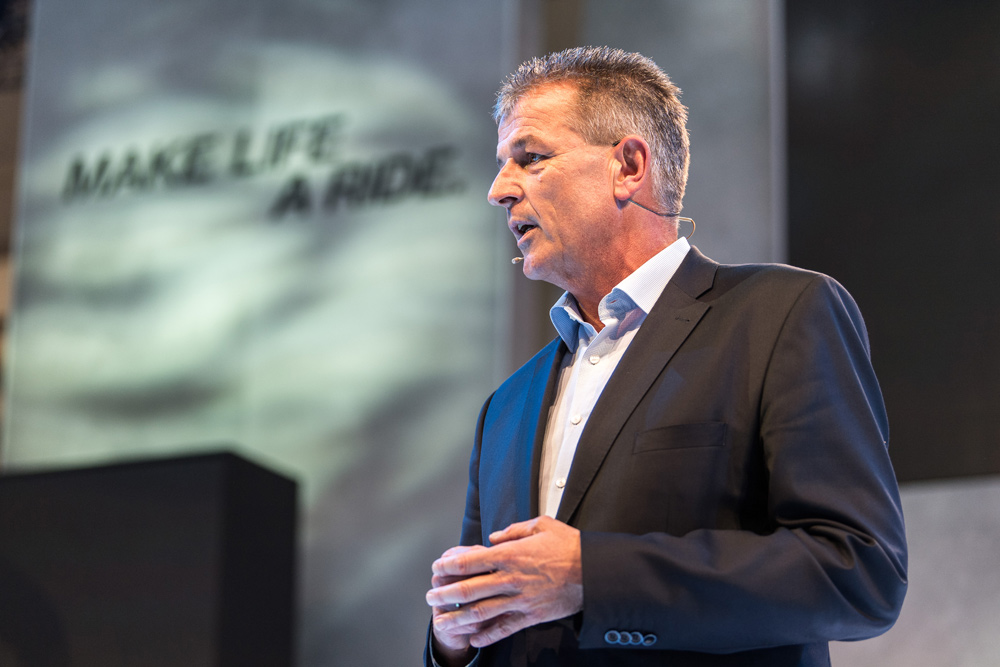 Schramm has also confirmed the BMW cruiser is in development, although was coy on a possible release date.
Schramm has also confirmed the BMW cruiser is in development, although was coy on a possible release date.
Can I ask if it will be a twin-cylinder solution?
Please spare me from revealing the technical details! I mean, we don’t normally announce further new models after revealing a mere six premieres here in Milan today, so.
I’m not asking whether it’s a Boxer twin or a V-twin, but whether it’s a twin-cylinder model as opposed to, say, a six-cylinder design?!
Okay, I understand—but let us just surprise you with the solution we’re working on. The wait will be worth it, you’ll see!
KTM’s best-selling 790 Duke has focused attention on the strategically important 750-900cc segment, and you’ve now launched BMW’s response to that in the F 850 GS Adventure. The KTM will be manufactured entirely in China from 2021 onwards, which presumably will allow it to be very competitive on price against rival middleweight models. Does BMW also envisage shifting production of its middleweight models offshore?
I think we are very happy with our current production network, and we are very successful in terms of managing the split between manufacturing any given model ourselves, or offshore. Don’t forget the engine in the new F 850 GS is produced in China already by Loncin, and they also produce the scooters in their entirety. We are very happy with our cooperation with them, and with TVS in India. I think the balance is always important to find—it’s not necessary to do everything offshore to get a competitively priced model built to our exacting standards of quality.
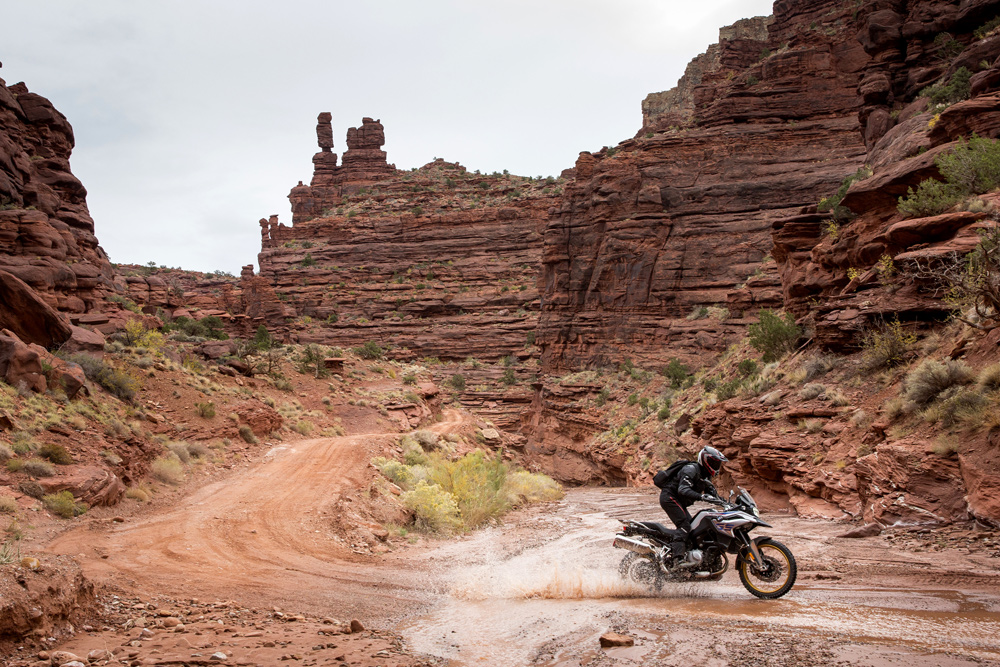 We’ve already tested the 850 GS in Moab earlier this year. It’s safe to say the new bike is an improvement over the near 10-year-old F 800 GS.
We’ve already tested the 850 GS in Moab earlier this year. It’s safe to say the new bike is an improvement over the near 10-year-old F 800 GS.
Do you foresee making M-versions of the F 850 platform, to give extra prestige and performance to the middleweight sector?
We have announced that we will have an M-package for the S 1000 RR, and I can tell you now we are not doing this only for one segment! There will be others—although that wasn’t the plan five months ago [when he took over as CEO—Ed]. So, we not only made a very quick decision, we also introduced it technically-wise very quickly, so that we have available the M-package with M-options and M-Performance Parts for the launch of the new S 1000 RR. Then after this we will expand the M-concept step-by-step—as I said, we won’t do this just for one package, or one model.
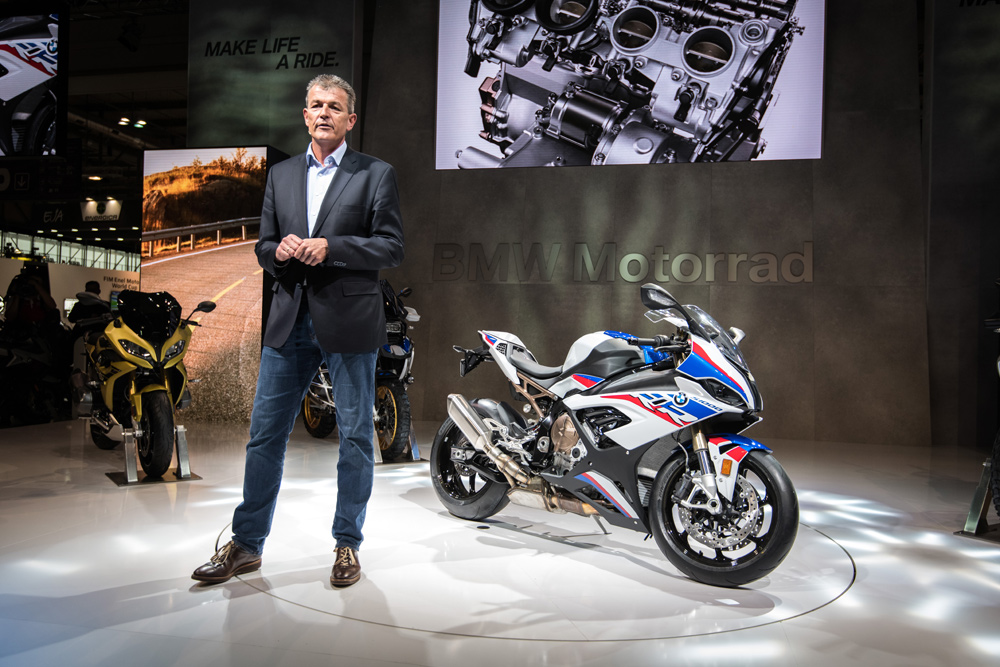
A high-performance version of the M-concept applied to the middleweight 850cc segment, would be to make a supercharged Kompressor version giving maximum performance in the middleweight segment, combined with light weight. The Kompressor concept is very much a key part of BMW’s traditions, which you allowed Kawasaki to steal from you! We’ve heard rumors from time to time about a modern Kompressor BMW, but never seen any such product. Is this something that BMW is looking at?
No, sorry. We are not considering a Kompressor model. I think we are not lacking power in our engines, so that is a clear no, we are not looking into this. And in terms of torque, our new Shift-Cam technology provides the perfect answer. You have already sampled it on the new R 1250 GS—but when you experience this on the Double-R, it’s even more dramatic—just wait! It’s really a big advantage, that you are already on the highest level of performance from the moment you open the throttle.
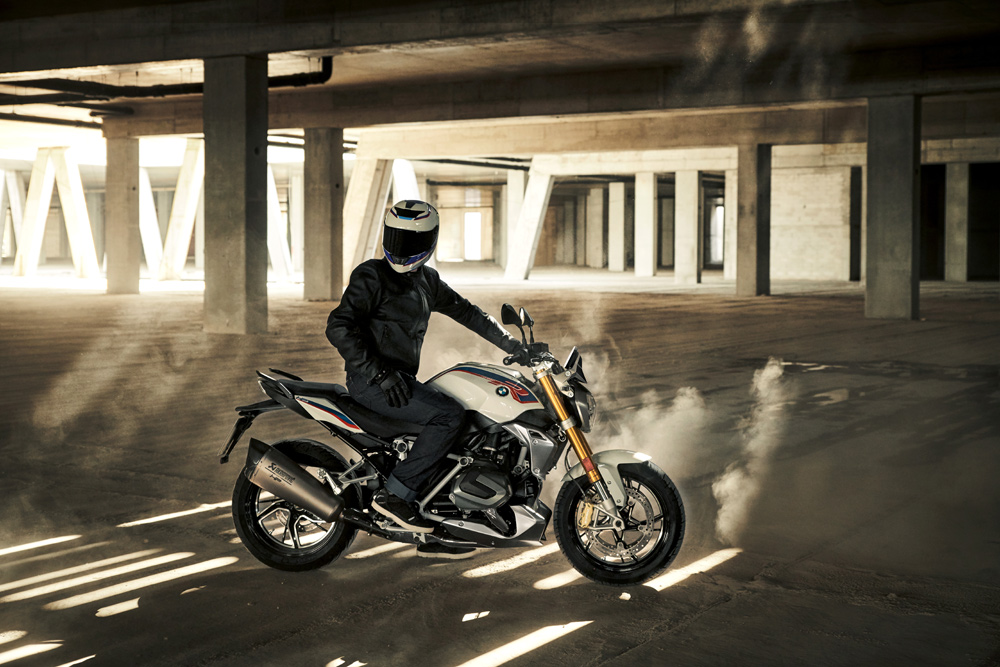
And I suppose that’s going to be even more useful when it reaches the S 1000 R Roadster and S 1000 XR?
Yes, I can promise you that’s the case!
So, BMW is building nicely, in which case when do you project breaking the 200,000 unit a year mark?
Our strategic target for reaching 200,000 annual sales is 2020—and not just for how well the figures are fitting together! We are well on course to achieve this target.
Can you do this within your existing factory in Berlin at Spandau with the existing structure?
Yes, we can. We are on a two-shift daily operation there, so we still have some potential to expand. We also have further potential with TVS. We have sufficient capacity, so we don’t need to build a new factory to achieve the 200,000 annual sales. CN